child restraint JEEP COMPASS 2021 Owner handbook (in English)
[x] Cancel search | Manufacturer: JEEP, Model Year: 2021, Model line: COMPASS, Model: JEEP COMPASS 2021Pages: 328, PDF Size: 8.85 MB
Page 105 of 328
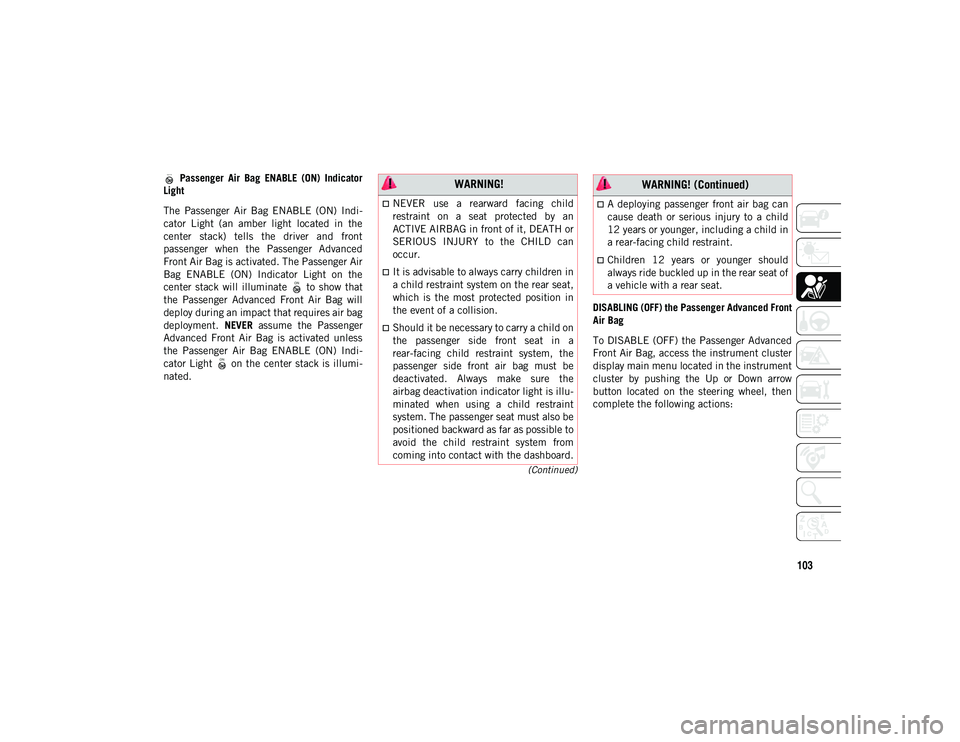
103
(Continued)
Passenger Air Bag ENABLE (ON) Indicator
Light
The Passenger Air Bag ENABLE (ON) Indi -
cator Light (an amber light located in the
center stack) tells the driver and front
passenger when the Passenger Advanced
Front Air Bag is activated. The Passenger Air
Bag ENABLE (ON) Indicator Light on the
center stack will illuminate to show that
the Passenger Advanced Front Air Bag will
deploy during an impact that requires air bag
deployment. NEVER assume the Passenger
Advanced Front Air Bag is activated unless
the Passenger Air Bag ENABLE (ON) Indi -
cator Light on the center stack is illumi -
nated. DISABLING (OFF) the Passenger Advanced Front
Air Bag
To DISABLE (OFF) the Passenger Advanced
Front Air Bag, access the instrument cluster
display main menu located in the instrument
cluster by pushing the Up or Down arrow
button located on the steering wheel, then
complete the following actions: WARNING!
NEVER use a rearward facing child
restraint on a seat protected by an
ACTIVE AIRBAG in front of it, DEATH or
SERIOUS INJURY to the CHILD can
occur.
It is advisable to always carry children in
a child restraint system on the rear seat,
which is the most protected position in
the event of a collision.
Should it be necessary to carry a child on
the passenger side front seat in a
rear-facing child restraint system, the
passenger side front air bag must be
deactivated. Always make sure the
airbag deactivation indicator light is illu
-
minated when using a child restraint
system. The passenger seat must also be
positioned backward as far as possible to
avoid the child restraint system from
coming into contact with the dashboard.
A deploying passenger front air bag can
cause death or serious injury to a child
12 years or younger, including a child in
a rear-facing child restraint.
Children 12 years or younger should
always ride buckled up in the rear seat of
a vehicle with a rear seat.
WARNING! (Continued)
2020_JEEP_M6_UG_UK.book Page 103
Page 109 of 328
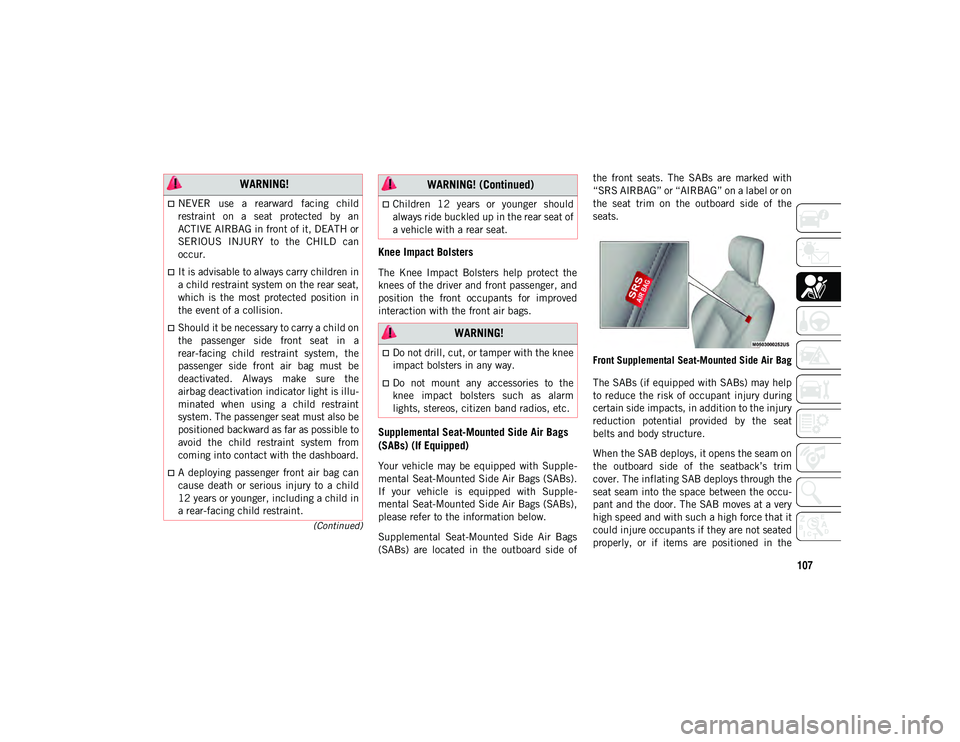
107
(Continued)
Knee Impact Bolsters
The Knee Impact Bolsters help protect the
knees of the driver and front passenger, and
position the front occupants for improved
interaction with the front air bags.
Supplemental Seat-Mounted Side Air Bags
(SABs) (If Equipped)
Your vehicle may be equipped with Supple-
mental Seat-Mounted Side Air Bags (SABs).
If your vehicle is equipped with Supple -
mental Seat-Mounted Side Air Bags (SABs),
please refer to the information below.
Supplemental Seat-Mounted Side Air Bags
(SABs) are located in the outboard side of the front seats. The SABs are marked with
“SRS AIRBAG” or “AIRBAG” on a label or on
the seat trim on the outboard side of the
seats.
Front Supplemental Seat-Mounted Side Air Bag
The SABs (if equipped with SABs) may help
to reduce the risk of occupant injury during
certain side impacts, in addition to the injury
reduction potential provided by the seat
belts and body structure.
When the SAB deploys, it opens the seam on
the outboard side of the seatback’s trim
cover. The inflating SAB deploys through the
seat seam into the space between the occu -
pant and the door. The SAB moves at a very
high speed and with such a high force that it
could injure occupants if they are not seated
properly, or if items are positioned in the
WARNING!
NEVER use a rearward facing child
restraint on a seat protected by an
ACTIVE AIRBAG in front of it, DEATH or
SERIOUS INJURY to the CHILD can
occur.
It is advisable to always carry children in
a child restraint system on the rear seat,
which is the most protected position in
the event of a collision.
Should it be necessary to carry a child on
the passenger side front seat in a
rear-facing child restraint system, the
passenger side front air bag must be
deactivated. Always make sure the
airbag deactivation indicator light is illu -
minated when using a child restraint
system. The passenger seat must also be
positioned backward as far as possible to
avoid the child restraint system from
coming into contact with the dashboard.
A deploying passenger front air bag can
cause death or serious injury to a child
12 years or younger, including a child in
a rear-facing child restraint.
Children 12 years or younger should
always ride buckled up in the rear seat of
a vehicle with a rear seat.
WARNING!
Do not drill, cut, or tamper with the knee
impact bolsters in any way.
Do not mount any accessories to the
knee impact bolsters such as alarm
lights, stereos, citizen band radios, etc.
WARNING! (Continued)
2020_JEEP_M6_UG_UK.book Page 107
Page 111 of 328
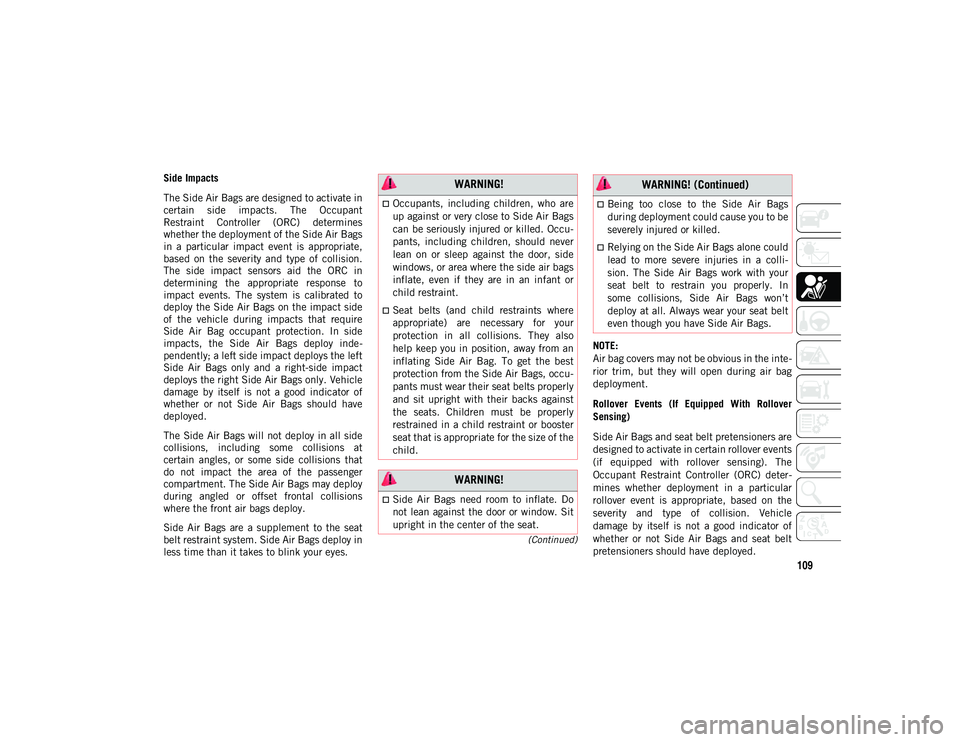
109
(Continued)
Side Impacts
The Side Air Bags are designed to activate in
certain side impacts. The Occupant
Restraint Controller (ORC) determines
whether the deployment of the Side Air Bags
in a particular impact event is appropriate,
based on the severity and type of collision.
The side impact sensors aid the ORC in
determining the appropriate response to
impact events. The system is calibrated to
deploy the Side Air Bags on the impact side
of the vehicle during impacts that require
Side Air Bag occupant protection. In side
impacts, the Side Air Bags deploy inde-
pendently; a left side impact deploys the left
Side Air Bags only and a right-side impact
deploys the right Side Air Bags only. Vehicle
damage by itself is not a good indicator of
whether or not Side Air Bags should have
deployed.
The Side Air Bags will not deploy in all side
collisions, including some collisions at
certain angles, or some side collisions that
do not impact the area of the passenger
compartment. The Side Air Bags may deploy
during angled or offset frontal collisions
where the front air bags deploy.
Side Air Bags are a supplement to the seat
belt restraint system. Side Air Bags deploy in
less time than it takes to blink your eyes. NOTE:
Air bag covers may not be obvious in the inte
-
rior trim, but they will open during air bag
deployment.
Rollover Events (If Equipped With Rollover
Sensing)
Side Air Bags and seat belt pretensioners are
designed to activate in certain rollover events
(if equipped with rollover sensing). The
Occupant Restraint Controller (ORC) deter -
mines whether deployment in a particular
rollover event is appropriate, based on the
severity and type of collision. Vehicle
damage by itself is not a good indicator of
whether or not Side Air Bags and seat belt
pretensioners should have deployed. WARNING!
Occupants, including children, who are
up against or very close to Side Air Bags
can be seriously injured or killed. Occu -
pants, including children, should never
lean on or sleep against the door, side
windows, or area where the side air bags
inflate, even if they are in an infant or
child restraint.
Seat belts (and child restraints where
appropriate) are necessary for your
protection in all collisions. They also
help keep you in position, away from an
inflating Side Air Bag. To get the best
protection from the Side Air Bags, occu -
pants must wear their seat belts properly
and sit upright with their backs against
the seats. Children must be properly
restrained in a child restraint or booster
seat that is appropriate for the size of the
child.
WARNING!
Side Air Bags need room to inflate. Do
not lean against the door or window. Sit
upright in the center of the seat.
Being too close to the Side Air Bags
during deployment could cause you to be
severely injured or killed.
Relying on the Side Air Bags alone could
lead to more severe injuries in a colli -
sion. The Side Air Bags work with your
seat belt to restrain you properly. In
some collisions, Side Air Bags won’t
deploy at all. Always wear your seat belt
even though you have Side Air Bags.
WARNING! (Continued)
2020_JEEP_M6_UG_UK.book Page 109
Page 116 of 328
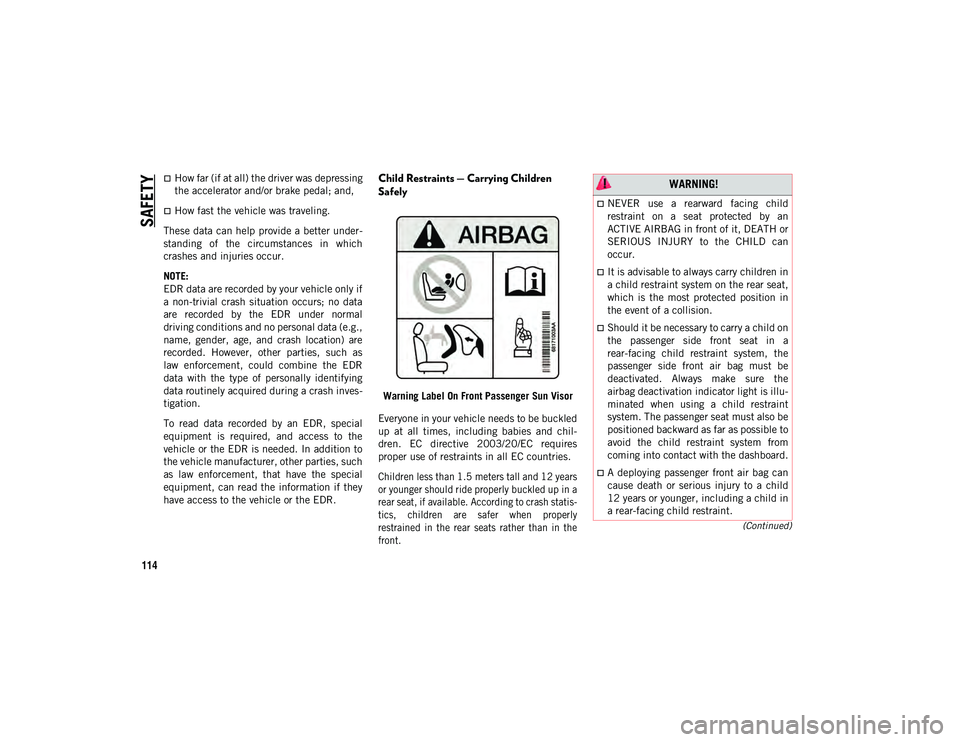
SAFETY
114
(Continued)
How far (if at all) the driver was depressing
the accelerator and/or brake pedal; and,
How fast the vehicle was traveling.
These data can help provide a better under -
standing of the circumstances in which
crashes and injuries occur.
NOTE:
EDR data are recorded by your vehicle only if
a non-trivial crash situation occurs; no data
are recorded by the EDR under normal
driving conditions and no personal data (e.g.,
name, gender, age, and crash location) are
recorded. However, other parties, such as
law enforcement, could combine the EDR
data with the type of personally identifying
data routinely acquired during a crash inves -
tigation.
To read data recorded by an EDR, special
equipment is required, and access to the
vehicle or the EDR is needed. In addition to
the vehicle manufacturer, other parties, such
as law enforcement, that have the special
equipment, can read the information if they
have access to the vehicle or the EDR.
Child Restraints — Carrying Children
Safely
Warning Label On Front Passenger Sun Visor
Everyone in your vehicle needs to be buckled
up at all times, including babies and chil -
dren. EC directive 2003/20/EC requires
proper use of restraints in all EC countries.
Children less than 1.5 meters tall and 12 years
or younger should ride properly buckled up in a
rear seat, if available. According to crash statis -
tics, children are safer when properly
restrained in the rear seats rather than in the
front.
WARNING!
NEVER use a rearward facing child
restraint on a seat protected by an
ACTIVE AIRBAG in front of it, DEATH or
SERIOUS INJURY to the CHILD can
occur.
It is advisable to always carry children in
a child restraint system on the rear seat,
which is the most protected position in
the event of a collision.
Should it be necessary to carry a child on
the passenger side front seat in a
rear-facing child restraint system, the
passenger side front air bag must be
deactivated. Always make sure the
airbag deactivation indicator light is illu -
minated when using a child restraint
system. The passenger seat must also be
positioned backward as far as possible to
avoid the child restraint system from
coming into contact with the dashboard.
A deploying passenger front air bag can
cause death or serious injury to a child
12 years or younger, including a child in
a rear-facing child restraint.
2020_JEEP_M6_UG_UK.book Page 114
Page 117 of 328
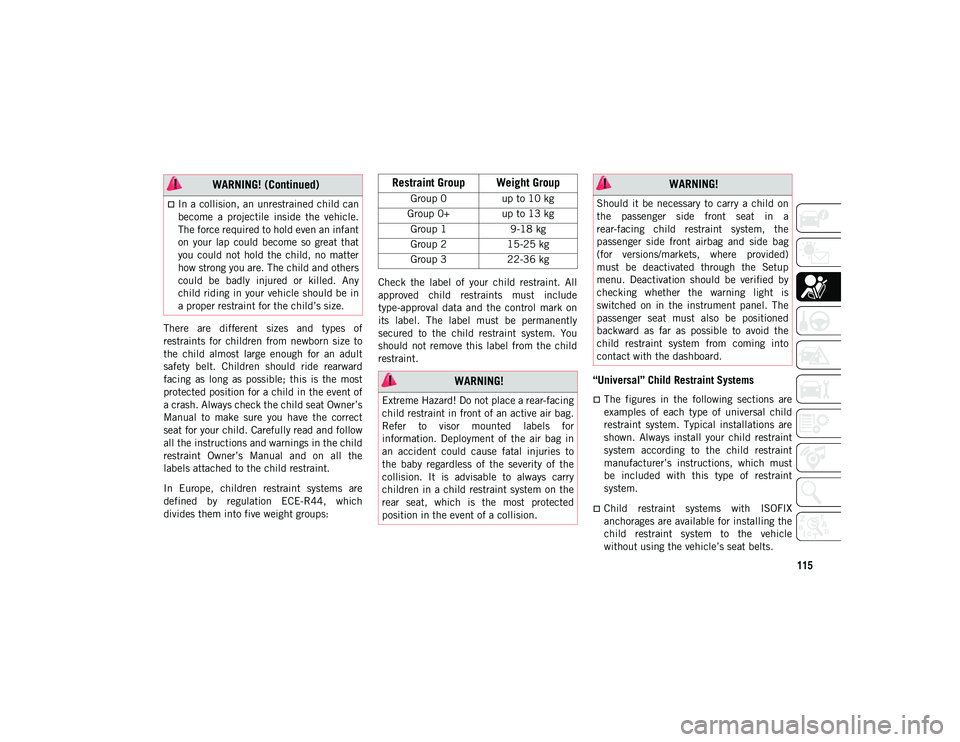
115
There are different sizes and types of
restraints for children from newborn size to
the child almost large enough for an adult
safety belt. Children should ride rearward
facing as long as possible; this is the most
protected position for a child in the event of
a crash. Always check the child seat Owner’s
Manual to make sure you have the correct
seat for your child. Carefully read and follow
all the instructions and warnings in the child
restraint Owner’s Manual and on all the
labels attached to the child restraint.
In Europe, children restraint systems are
defined by regulation ECE-R44, which
divides them into five weight groups:Check the label of your child restraint. All
approved child restraints must include
type-approval data and the control mark on
its label. The label must be permanently
secured to the child restraint system. You
should not remove this label from the child
restraint.
“Universal” Child Restraint Systems
The figures in the following sections are
examples of each type of universal child
restraint system. Typical installations are
shown. Always install your child restraint
system according to the child restraint
manufacturer’s instructions, which must
be included with this type of restraint
system.
Child restraint systems with ISOFIX
anchorages are available for installing the
child restraint system to the vehicle
without using the vehicle’s seat belts.
In a collision, an unrestrained child can
become a projectile inside the vehicle.
The force required to hold even an infant
on your lap could become so great that
you could not hold the child, no matter
how strong you are. The child and others
could be badly injured or killed. Any
child riding in your vehicle should be in
a proper restraint for the child’s size.
WARNING! (Continued)Restraint Group Weight Group
Group 0
up to 10 kg
Group 0+ up to 13 kg
Group 1 9-18 kg
Group 2 15-25 kg
Group 3 22-36 kg
WARNING!
Extreme Hazard! Do not place a rear-facing
child restraint in front of an active air bag.
Refer to visor mounted labels for
information. Deployment of the air bag in
an accident could cause fatal injuries to
the baby regardless of the severity of the
collision. It is advisable to always carry
children in a child restraint system on the
rear seat, which is the most protected
position in the event of a collision.
WARNING!
Should it be necessary to carry a child on
the passenger side front seat in a
rear-facing child restraint system, the
passenger side front airbag and side bag
(for versions/markets, where provided)
must be deactivated through the Setup
menu. Deactivation should be verified by
checking whether the warning light is
switched on in the instrument panel. The
passenger seat must also be positioned
backward as far as possible to avoid the
child restraint system from coming into
contact with the dashboard.
2020_JEEP_M6_UG_UK.book Page 115
Page 118 of 328
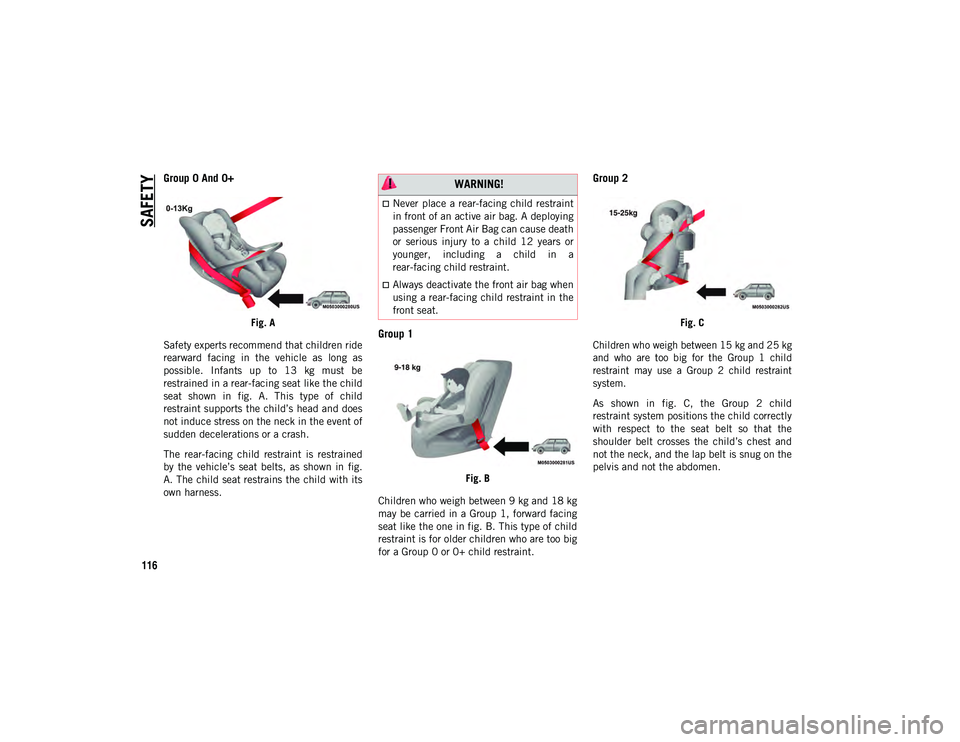
SAFETY
116
Group 0 And 0+
Fig. A
Safety experts recommend that children ride
rearward facing in the vehicle as long as
possible. Infants up to 13 kg must be
restrained in a rear-facing seat like the child
seat shown in fig. A. This type of child
restraint supports the child’s head and does
not induce stress on the neck in the event of
sudden decelerations or a crash.
The rear-facing child restraint is restrained
by the vehicle’s seat belts, as shown in fig.
A. The child seat restrains the child with its
own harness.Group 1
Fig. B
Children who weigh between 9 kg and 18 kg
may be carried in a Group 1, forward facing
seat like the one in fig. B. This type of child
restraint is for older children who are too big
for a Group 0 or 0+ child restraint.
Group 2
Fig. C
Children who weigh between 15 kg and 25 kg
and who are too big for the Group 1 child
restraint may use a Group 2 child restraint
system.
As shown in fig. C, the Group 2 child
restraint system positions the child correctly
with respect to the seat belt so that the
shoulder belt crosses the child’s chest and
not the neck, and the lap belt is snug on the
pelvis and not the abdomen.
WARNING!
Never place a rear-facing child restraint
in front of an active air bag. A deploying
passenger Front Air Bag can cause death
or serious injury to a child 12 years or
younger, including a child in a
rear-facing child restraint.
Always deactivate the front air bag when
using a rear-facing child restraint in the
front seat.
2020_JEEP_M6_UG_UK.book Page 116
Page 119 of 328
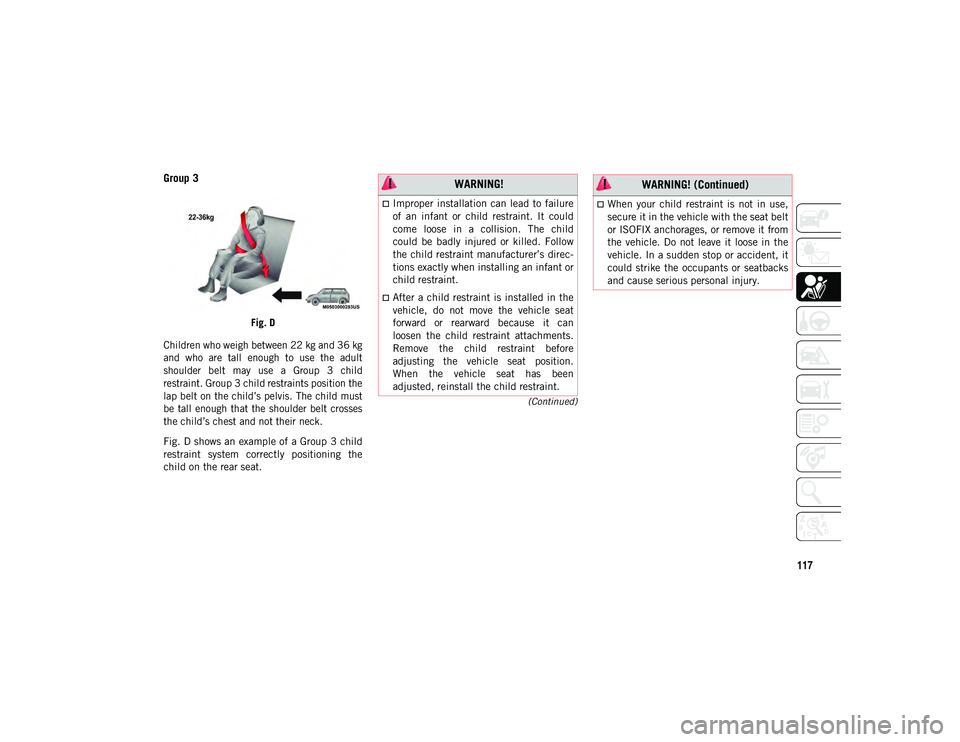
117
(Continued)
Group 3
Fig. D
Children who weigh between 22 kg and 36 kg
and who are tall enough to use the adult
shoulder belt may use a Group 3 child
restraint. Group 3 child restraints position the
lap belt on the child’s pelvis. The child must
be tall enough that the shoulder belt crosses
the child’s chest and not their neck.
Fig. D shows an example of a Group 3 child
restraint system correctly positioning the
child on the rear seat.
WARNING!
Improper installation can lead to failure
of an infant or child restraint. It could
come loose in a collision. The child
could be badly injured or killed. Follow
the child restraint manufacturer’s direc-
tions exactly when installing an infant or
child restraint.
After a child restraint is installed in the
vehicle, do not move the vehicle seat
forward or rearward because it can
loosen the child restraint attachments.
Remove the child restraint before
adjusting the vehicle seat position.
When the vehicle seat has been
adjusted, reinstall the child restraint.
When your child restraint is not in use,
secure it in the vehicle with the seat belt
or ISOFIX anchorages, or remove it from
the vehicle. Do not leave it loose in the
vehicle. In a sudden stop or accident, it
could strike the occupants or seatbacks
and cause serious personal injury.
WARNING! (Continued)
2020_JEEP_M6_UG_UK.book Page 117
Page 120 of 328
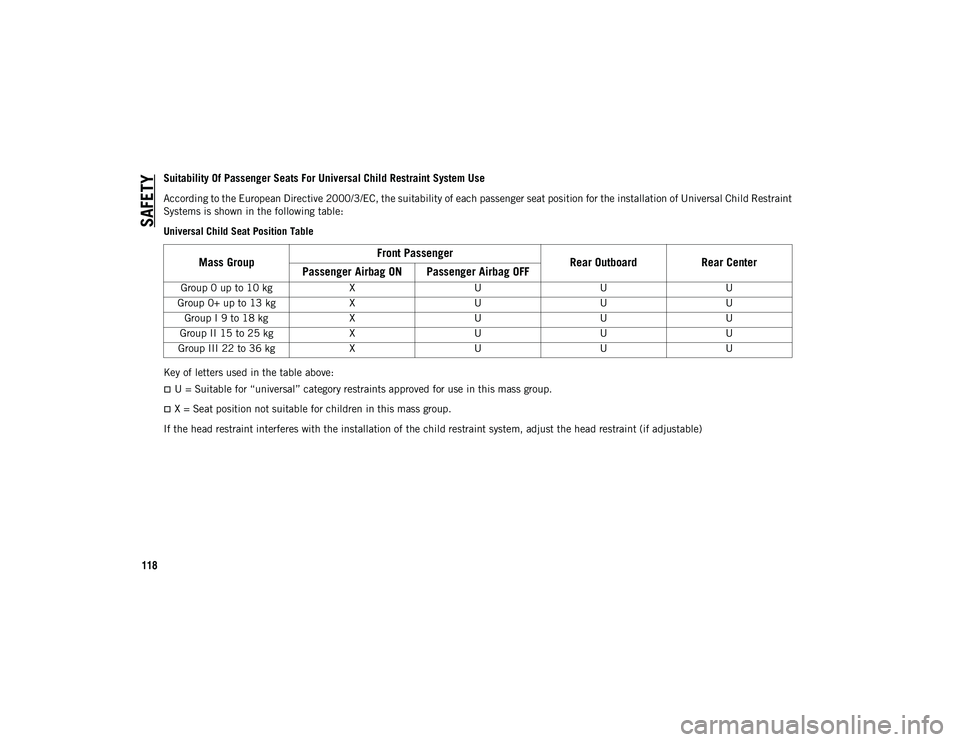
SAFETY
118
Suitability Of Passenger Seats For Universal Child Restraint System Use
According to the European Directive 2000/3/EC, the suitability of each passenger seat position for the installation of Universal Child Restraint
Systems is shown in the following table:
Universal Child Seat Position Table
Key of letters used in the table above:
U = Suitable for “universal” category restraints approved for use in this mass group.
X = Seat position not suitable for children in this mass group.
If the head restraint interferes with the installation of the child restraint system, adjust the head restraint (if adjustable)
Mass Group Front Passenger
Rear OutboardRear Center
Passenger Airbag ON Passenger Airbag OFF
Group 0 up to 10 kg XU UU
Group 0+ up to 13 kg XU UU
Group I 9 to 18 kg XU UU
Group II 15 to 25 kg XU UU
Group III 22 to 36 kg XU UU
2020_JEEP_M6_UG_UK.book Page 118
Page 122 of 328
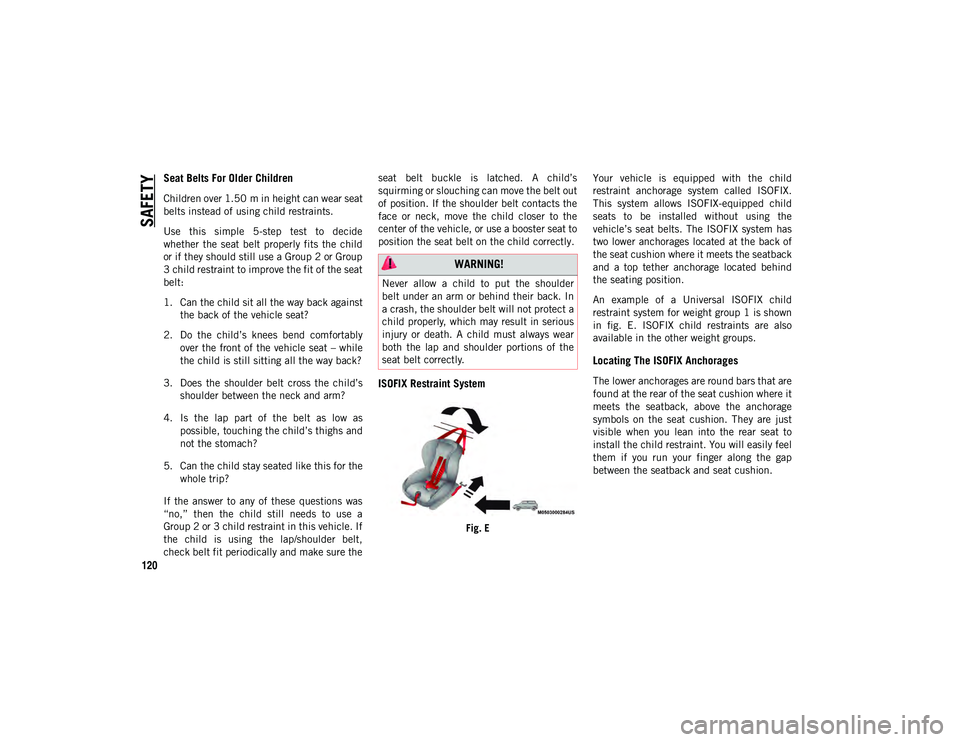
SAFETY
120
Seat Belts For Older Children
Children over 1.50 m in height can wear seat
belts instead of using child restraints.
Use this simple 5-step test to decide
whether the seat belt properly fits the child
or if they should still use a Group 2 or Group
3 child restraint to improve the fit of the seat
belt:
1. Can the child sit all the way back againstthe back of the vehicle seat?
2. Do the child’s knees bend comfortably over the front of the vehicle seat – while
the child is still sitting all the way back?
3. Does the shoulder belt cross the child’s shoulder between the neck and arm?
4. Is the lap part of the belt as low as possible, touching the child’s thighs and
not the stomach?
5. Can the child stay seated like this for the whole trip?
If the answer to any of these questions was
“no,” then the child still needs to use a
Group 2 or 3 child restraint in this vehicle. If
the child is using the lap/shoulder belt,
check belt fit periodically and make sure the seat belt buckle is latched. A child’s
squirming or slouching can move the belt out
of position. If the shoulder belt contacts the
face or neck, move the child closer to the
center of the vehicle, or use a booster seat to
position the seat belt on the child correctly.
ISOFIX Restraint System
Fig. E
Your vehicle is equipped with the child
restraint anchorage system called ISOFIX.
This system allows ISOFIX-equipped child
seats to be installed without using the
vehicle’s seat belts. The ISOFIX system has
two lower anchorages located at the back of
the seat cushion where it meets the seatback
and a top tether anchorage located behind
the seating position.
An example of a Universal ISOFIX child
restraint system for weight group 1 is shown
in fig. E. ISOFIX child restraints are also
available in the other weight groups.
Locating The ISOFIX Anchorages
The lower anchorages are round bars that are
found at the rear of the seat cushion where it
meets the seatback, above the anchorage
symbols on the seat cushion. They are just
visible when you lean into the rear seat to
install the child restraint. You will easily feel
them if you run your finger along the gap
between the seatback and seat cushion.
WARNING!
Never allow a child to put the shoulder
belt under an arm or behind their back. In
a crash, the shoulder belt will not protect a
child properly, which may result in serious
injury or death. A child must always wear
both the lap and shoulder portions of the
seat belt correctly.
2020_JEEP_M6_UG_UK.book Page 120
Page 123 of 328
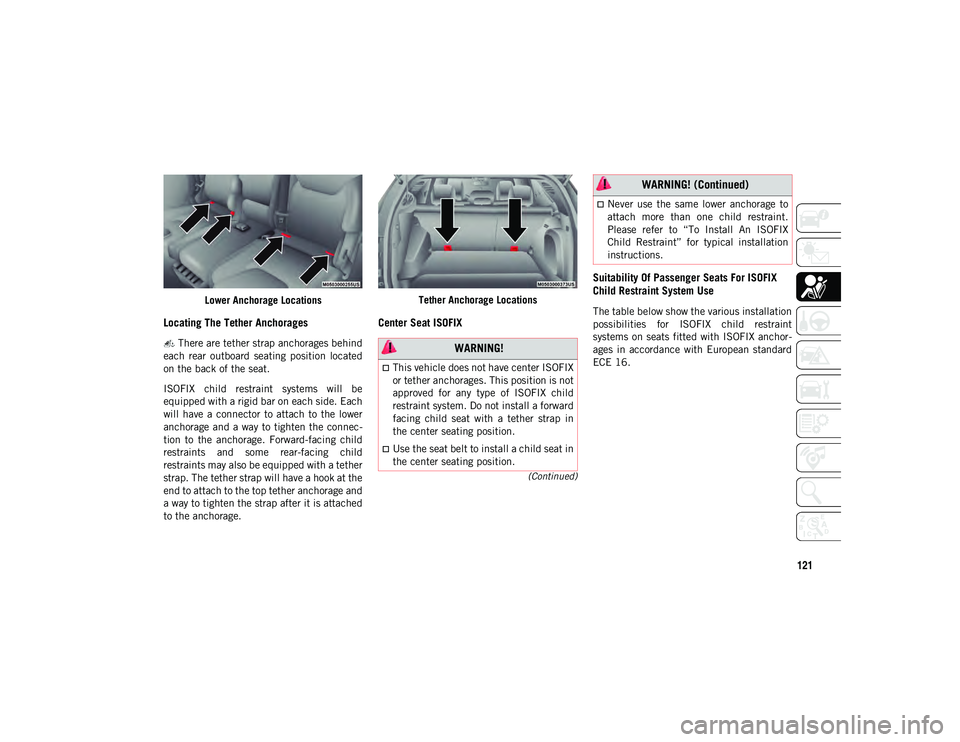
121
(Continued)
Lower Anchorage Locations
Locating The Tether Anchorages
There are tether strap anchorages behind
each rear outboard seating position located
on the back of the seat.
ISOFIX child restraint systems will be
equipped with a rigid bar on each side. Each
will have a connector to attach to the lower
anchorage and a way to tighten the connec -
tion to the anchorage. Forward-facing child
restraints and some rear-facing child
restraints may also be equipped with a tether
strap. The tether strap will have a hook at the
end to attach to the top tether anchorage and
a way to tighten the strap after it is attached
to the anchorage. Tether Anchorage Locations
Center Seat ISOFIX
Suitability Of Passenger Seats For ISOFIX
Child Restraint System UseThe table below show the various installation
possibilities for ISOFIX child restraint
systems on seats fitted with ISOFIX anchor
-
ages in accordance with European standard
ECE 16.
WARNING!
This vehicle does not have center ISOFIX
or tether anchorages. This position is not
approved for any type of ISOFIX child
restraint system. Do not install a forward
facing child seat with a tether strap in
the center seating position.
Use the seat belt to install a child seat in
the center seating position.
Never use the same lower anchorage to
attach more than one child restraint.
Please refer to “To Install An ISOFIX
Child Restraint” for typical installation
instructions.
WARNING! (Continued)
2020_JEEP_M6_UG_UK.book Page 121